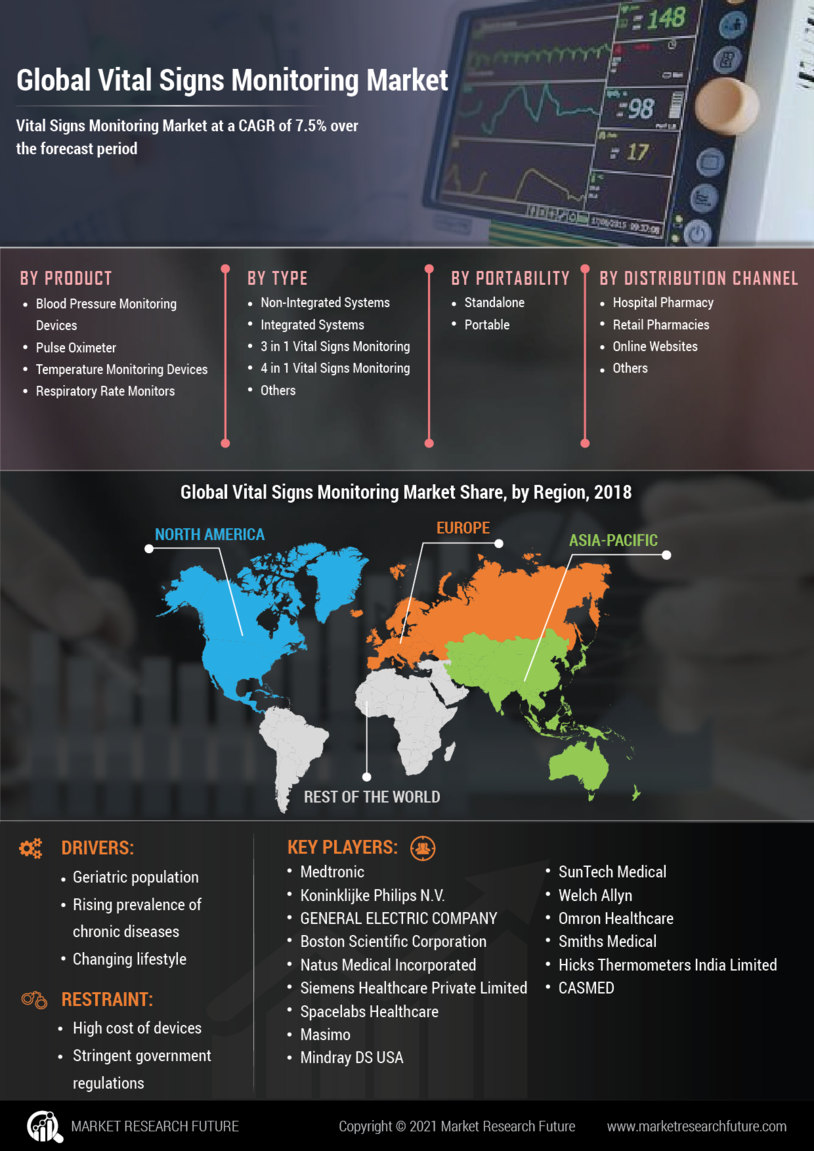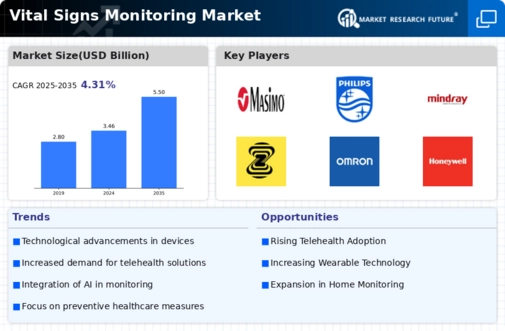Rising Prevalence of Chronic Diseases
The increasing incidence of chronic diseases such as diabetes, cardiovascular disorders, and respiratory conditions is a primary driver for the Vital Signs Monitoring Market. As these conditions require continuous monitoring to manage effectively, healthcare providers are increasingly adopting advanced monitoring solutions. According to recent data, chronic diseases account for approximately 70% of all deaths worldwide, underscoring the urgent need for effective monitoring systems. This trend is likely to propel the demand for vital signs monitoring devices, as they play a crucial role in early detection and management of these diseases. Consequently, the Vital Signs Monitoring Market is expected to witness substantial growth as healthcare systems prioritize patient-centered care and proactive health management.
Growing Awareness of Preventive Healthcare
There is a notable increase in awareness regarding preventive healthcare, which is influencing the Vital Signs Monitoring Market. As individuals become more health-conscious, there is a rising demand for tools that enable proactive health management. This shift towards preventive care is prompting healthcare providers to incorporate vital signs monitoring into routine check-ups and wellness programs. The Vital Signs Monitoring Market is projected to reach USD 4 trillion by 2026, indicating a significant opportunity for growth in the vital signs monitoring sector. By facilitating early detection of health issues, vital signs monitoring devices are becoming essential components of preventive healthcare strategies, thereby driving their adoption across various healthcare settings.
Increasing Demand for Home Healthcare Solutions
The growing preference for home healthcare solutions is reshaping the Vital Signs Monitoring Market. Patients increasingly favor receiving care in the comfort of their homes, leading to a surge in demand for portable and user-friendly monitoring devices. This trend is particularly evident among the elderly population, who often require regular monitoring for chronic conditions. The home healthcare market is anticipated to grow at a compound annual growth rate of 8.5% through 2027, reflecting the rising acceptance of home-based care. As a result, manufacturers are focusing on developing innovative vital signs monitoring devices tailored for home use, thereby expanding their market reach and enhancing patient engagement.
Regulatory Support for Remote Patient Monitoring
Regulatory bodies are increasingly supporting remote patient monitoring initiatives, which is positively impacting the Vital Signs Monitoring Market. Policies aimed at promoting telehealth and remote monitoring solutions are being implemented to improve healthcare access and efficiency. For example, reimbursement policies for telehealth services have been expanded, encouraging healthcare providers to adopt remote monitoring technologies. This regulatory support is expected to drive the growth of the vital signs monitoring market, as it facilitates the integration of monitoring devices into routine care. The potential for improved patient outcomes and reduced healthcare costs further underscores the importance of regulatory frameworks in shaping the future of the Vital Signs Monitoring Market.
Technological Advancements in Monitoring Devices
Technological innovations are significantly transforming the Vital Signs Monitoring Market. The advent of sophisticated monitoring devices equipped with advanced sensors and connectivity features enhances the accuracy and reliability of vital signs measurement. For instance, the integration of artificial intelligence and machine learning algorithms into monitoring systems allows for real-time data analysis and predictive analytics. This not only improves patient outcomes but also streamlines clinical workflows. The market for wearable health technology is projected to reach USD 60 billion by 2025, indicating a robust growth trajectory. Such advancements are likely to drive the adoption of vital signs monitoring solutions, as healthcare providers seek to leverage technology for improved patient care.


















Leave a Comment